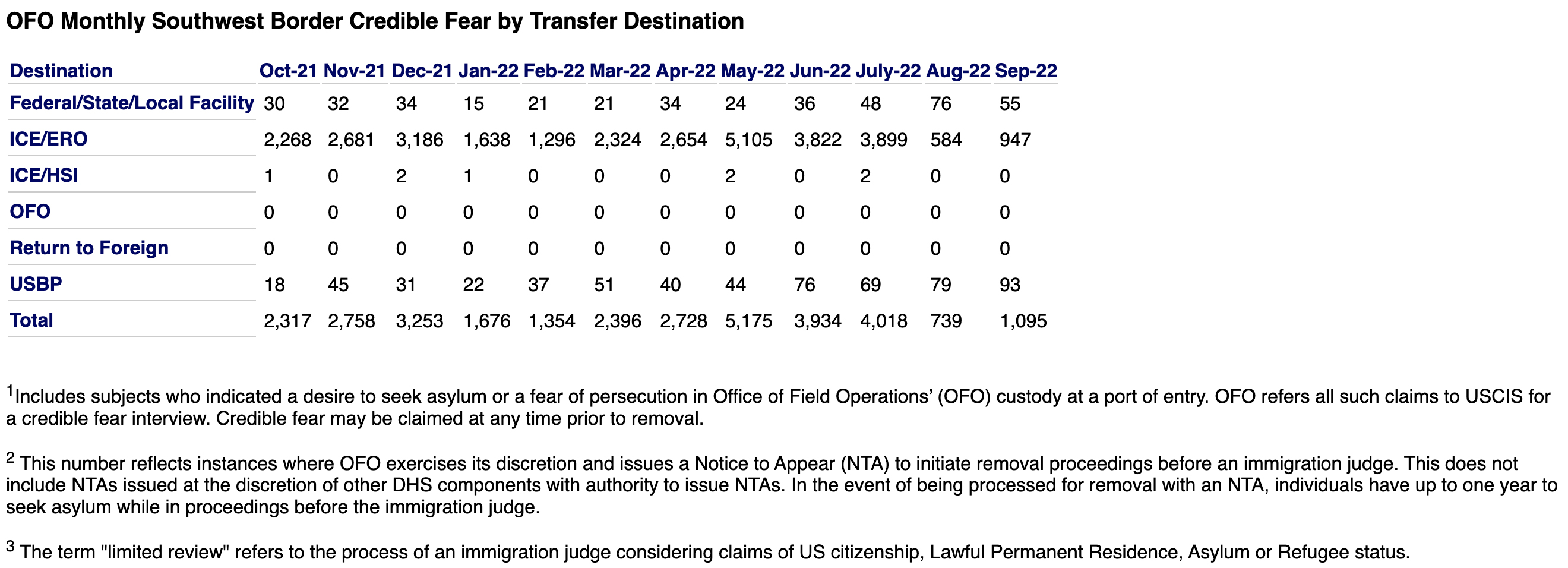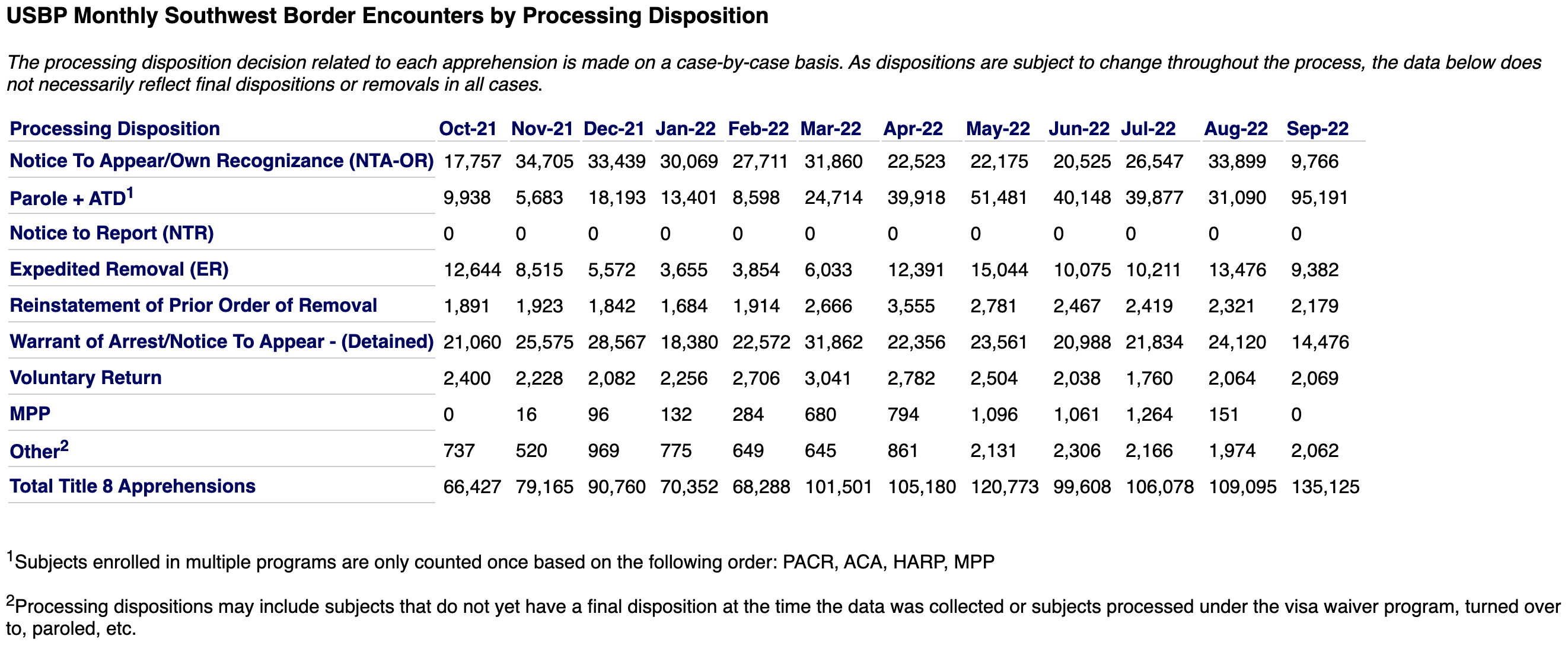How Long Does Biden’s DHS Wait to Put Paroled Border Migrants into Removal Proceedings?
The most important question — the biggest “unknown unknown” of the Biden border crisis — is how long DHS is waiting before placing aliens encountered by CBP at the Southwest border (including illegal migrants) into removal proceedings. And yet, it’s the one question no one in the media or Congress is asking. They should, because we can’t really grasp the scope of the disaster until we know the answer, which touches on the administration’s claims that most border migrants are showing up in immigration court.
CBP Southwest Border Encounters Defined and Quantified. CBP Southwest border “encounters” are the sum of migrants apprehended by Border Patrol agents plus aliens deemed inadmissible at the ports. We know that number: nearly 2.4 million in FY 2022 (2.2 million-plus apprehensions and just over 172,500 aliens at the ports).
We also know how many migrants encountered at the Southwest border have been expelled under CDC orders issued pursuant to Title 42 of the U.S. Code in response to the Covid-19 pandemic, and the number of encountered migrants who were processed for removal under the Immigration and Nationality Act (INA) in lieu of Title 42 expulsion: Short of 1.080 million Title 42 expulsions in FY 2022, and about 1.3 million aliens who were processed for removal.
CBP Southwest Border Releases. The numbers get a little fuzzier when it comes to how many migrants who were released by CBP into the United States were processed for removal under the INA.
CBP statistics reveal that in FY 2022, Border Patrol released just fewer than 311,000 migrants it apprehended at the Southwest border on their own recognizance (“OR” without bond or other conditions) with a Notice to Appear (NTA), and released just over 338,000 others on “Parole+ATD”:
Parole+ATD stands for “parole” under section 212(d)(5)(A) of the INA plus “alternatives to detention” (ATD), like GPS tracking, ankle monitors, or (more commonly) the SmartLINK app. I will put aside for this analysis that DHS lacks the authority to release illegal entrants en masse on parole, can’t release any of them on their own recognizance, and that “ATD” is both costly and ineffective.
The “NTA” is the charging document DHS is required by statute to use in placing aliens into removal proceedings, so I know that about 311,000 migrants who were apprehended by Border Patrol agents in FY 2022 were released to appear before an immigration judge on a date certain. Of course, I have no idea when those aliens are scheduled to appear in court, and more specifically whether those aliens were given a week, a month, a year, or longer to show up in immigration court.
CBP’s reports show that the agency’s Office of Field Operations (OFO), which runs inspections at the ports, issued nearly 91,000 “Notices to Appear” (NTAs) to aliens deemed inadmissible at the Southwest border in FY 2022.
Again, the NTA is the charging document for removal proceedings, so I know those aliens were scheduled to appear before immigration judges. That said, I don’t know how many were detained, because even though CBP’s statistics page includes separate columns for aliens issued NTAs who were “released” or alternatively “detained” monthly, the answer is “zero” for each month in both columns. That’s both a legal and physical impossibility.
 |
Even more curious, however, is that OFO statistics don’t provide any data on the number of aliens to whom it issued NTAs who were released on parole (either with or without ATD), or on the alien’s own recognizance, or were simply pushed out the door. Not than any of them should have been released at all, but again something had to have happened to them.
That said, OFO reports that it sent just over 30,400 inadmissible aliens to ICE’s Office of Enforcement and Removal Operations (ERO) in FY 2022.
 |
ERO detains aliens, but whether it continued to detain those aliens or released some, most, or all of them once it took custody is anybody’s guess. And of course, I have no idea what happened to the other 60,000 or so who weren’t sent to ERO.
All told, however, between Border Patrol and OFO, I know that about 204,000 migrants encountered by CBP at the Southwest border in FY 2022 were placed into removal proceedings after service of an NTA, albeit for hearing dates unknown. They might have been required to show up last fiscal year or in FY 2023, but then their hearings may not be set until 2030 or later.
Parole (with a Brief Detour into Expedited Removal). Which brings me to the most opaque and inscrutable cadre of border migrants — those released on parole. Explaining that opacity will require a brief detour into “expedited removal”.
DHS’s authority to parole aliens into the United States is tightly constrained by statute: DHS may parole aliens “only on a case-by-case basis for urgent humanitarian reasons or significant public benefit”.
That’s important, because section 235(b) of the INA requires DHS to detain all aliens who have entered illegally or who are deemed inadmissible at the ports — from the moment they are apprehended until they are admitted, granted asylum or some other lawful immigration status, or removed. Congress imposed those restrictions in 1996.
In that same 1996 act, Congress also gave DHS the authority to quickly remove arriving aliens without valid entry documents (including illegal entrants), without DHS having to place those aliens into removal proceedings. That procedure is known as “expedited removal”.
The statute, however, requires CBP to refer aliens subject to expedited removal to USCIS asylum officers if they assert a fear of harm if returned or request asylum, to allow those asylum officers to determine whether those aliens have a “credible fear” of persecution.
Credible fear is a screening process to determine whether an alien may have an asylum claim, and the credible fear standard is consequently low: “a significant possibility, taking into account the credibility of the statements made by the alien in support of the alien’s claim and such other facts as are known to the officer, that the alien could establish eligibility for asylum”.
If an alien receives a “positive credible fear determination” from an asylum officer (and most who make a protection claim do because the standard is so low), the expedited removal provision directs DHS to place the alien into removal proceedings to apply for asylum.
For more than a dozen years after the expedited removal/credible fear process was added to the INA, the former INS and its successor agencies in DHS at least tried to comply with the 1996 detention mandate.
As a result, few aliens subject to expedited removal (between 4 and 5 percent from FY 2006 and FY 2009, for example) claimed credible fear when they were encountered.
The Morton Directive and the New Biden Parole Policy. That changed, however, in December 2009, when then-ICE Director John Morton ordered his agency to parole every alien subject to expedited removal (again, including illegal entrants) who had received a positive credible fear determination from an asylum officer, unless there were questions about the alien’s identity or concerns that the alien posed a flight risk or a danger to the community.
Not surprisingly, an increasing number of aliens in expedited removal made credible fear claims thereafter, with 44 percent of aliens subject to expedited removal claiming credible fear by FY 2017. Migrants (and more particularly, their smugglers) had come to realize that such claims were veritable free tickets into the United States.
Note, however, that aliens released from custody on parole under the Morton directive were still placed into removal proceedings before they were released — those hearings were simply held in a non-detained, as compared to detained, setting. That’s now changed, because the Biden administration is not issuing NTAs to the border migrants it paroles from custody.
For proof, I turn to a letter DHS Secretary Alejandro Mayorkas sent to Sen. Ron Johnson (R-Wisc.) in early 2022. The DHS secretary explained therein: “In general, [an alien] who is paroled into the United States is not placed into removal proceedings until the parole is terminated”.
When Are Paroled Aliens Being Placed into Removal Proceedings? That statement raises a whole host of questions.
By regulation, parole terminates in one of four situations: (1) without notice when the alien departs the United States; (2) without notice when the authorized period for parole ends; (3) with notice, when the “purpose for which parole was authorized” is “accomplished”; or (4) with notice, when “neither humanitarian reasons nor public benefit warrants the continued presence of the alien in the United States”.
Only the last three would appear to apply to border migrants released by DHS from custody on parole, and Biden’s DHS has been mum on: (1) whether it is granting parole to migrants good to a date certain; (2) what specific “purposes” (if any) it is releasing those migrants to accomplish; or (3) under what circumstances (if any) it reconsiders whether “neither humanitarian reasons nor public benefit warrants the continued presence of” border migrants paroled into this country.
The Biden administration’s argument for releasing hundreds of thousands of migrants on parole is that it lacks detention space to hold them, and thus releasing low-risk migrants constitutes a “significant public benefit”, as it frees up space for more dangerous offenders. That a lot of ICE detention space is sitting empty is an apparent afterthought.
Notwithstanding Mayorkas’ statements to Sen. Johnson, however, those paroled border migrants remain removable, and are supposed to be placed into removal proceedings. The question is when and how those aliens are served with NTAs.
When it releases those migrants on parole, Biden’s DHS may be giving them a date by which they are expected to appear at an ICE office to be served with an NTA. If that’s the case, then parole would terminate when those aliens appear (satisfying the purpose of parole) or, if they fail to appear, the missed appearance date.
Or, alternatively, DHS may be releasing those aliens on indefinite parole to appear at an ICE office for the service of the NTA at a date to be determined, with the proviso that DHS will be notifying the alien (either in person or electronically) of the date by which the alien is expected to appear.
Those are the only two logical conclusions, and each is supported by Mayorkas’ statement to Sen. Johnson that aliens aren’t placed into removal proceedings until their parole is terminated. By showing up on a date certain to accomplish the purpose for which parole was granted (appearing at ICE for service of the NTA, kicking off removal proceedings), parole would terminate automatically.
That still doesn’t explain how much time DHS is giving those paroled border migrants to show up at an ICE office to be served with their NTAs.
Back in May, Epoch Times reported that paroled border migrants were being given a year to settle in before they had to appear at ICE offices to be served with NTAs. In the interim, however, Border Patrol at the Southwest border has paroled in more than 496,000 new migrants — 206,000-plus between June and September 2022 and nearly 290,000 in the first three months of FY 2023.
When Mayorkas stifled the ability of ICE ERO officers to pursue most removable aliens in the United States via “enforcement guidelines” he issued in September 2021 (currently vacated pending Supreme Court review), he likely freed many of them up to sit around and wait for paroled border migrants to appear.
That said, if DHS was sticking to the one-year parole appearance standard referenced in the Epoch Times, ICE officers would have had to have reserved nearly 1,360 appointment slots per day for those migrants to serve those migrants with NTAs. That’s a blistering pace, particularly given that many, most, or all of those migrants might never show up.
Given that, the logical conclusion is that DHS is paroling border migrants for years before expecting them to appear at ICE for service of their NTAs — time those aliens can live and work in this country and build up the sorts of equities (children, home ownership, jobs) that would allow them to remain here forever.
The Administration’s Claims on Immigration Court “No-Shows”. Which brings me to “no-shows” — border migrants who have been released into the United States, issued NTAs, and scheduled for immigration court hearings at which they fail to appear.
During Mayorkas’ May 4 appearance before the Senate Homeland Security and Governmental Affairs Committee (HSGAC), Sen. James Lankford (R-Okla.) confronted Mayorkas over DHS’s non-detention of migrants, and those migrants’ subsequent failures to appear in immigration court.
Specifically, according to PolitiFact, Sen. Lankford stated: “You say detention is used when you’re not sure if they’re going to show up for hearings. The vast majority of individuals that we’re releasing out are not showing up for hearings.”
Mayorkas “pushed back”, asserting “the data evidence is that the majority of people show up for their hearings.” Consequently, PolitiFact rated Sen. Lankford’s statement “false”.
Sen. Lankford’s statement, and Mayorkas’ response, however, both assume that DHS is releasing migrants at the Southwest border on parole and is immediately placing those migrants into removal proceedings. Mayorkas’ letter to Sen. Johnson proves that’s not true.
Moreover, even assuming that CBP is serving NTAs on the 311,000 border migrants that it released on their own recognizance (plus the 91,000 aliens who were issued NTAs by OFO), there is nothing that suggests that those hundreds of thousands of aliens have yet had an initial court date — at which time they would be expected to appear, or alternatively at which they would have failed to show.
Anecdotally, and as an aside, I have heard from numerous sources that ICE attorneys have been told not to seek in absentia removal orders on released border migrants who aren’t showing up in court. Despite that fact, more than 62,000 alien respondents in immigration court were ordered removed in absentia in FY 2022.
Just short of 10,200 of those aliens had been released from custody, but notably DOJ explains that this figure does not include aliens “released from custody prior to the initiation of removal … proceedings” — a category that would include released border migrants. That’s fishy.
Biden’s border parole policies are being challenged by state plaintiffs in two separate cases: Texas v. Biden and U.S. v. Florida. The judges in those cases might want to know whether border migrants are being paroled into the United States for years before they are expected to appear in immigration court, if that’s the case.
The only entity that will be able to get answers to the question of whether border migrants are being paroled into the United States for extended periods of time — one year, five years, 10 years, or more — before they are even expected to show up in immigration court is Congress. If members haven’t asked that question yet, they should. They may also want to ask how many of those aliens were told to appear for service of their NTAs, who didn’t show up, and what DHS is doing to find them.






